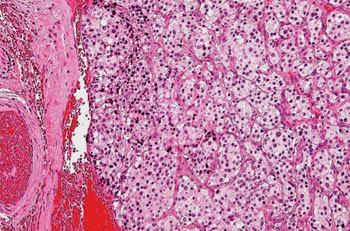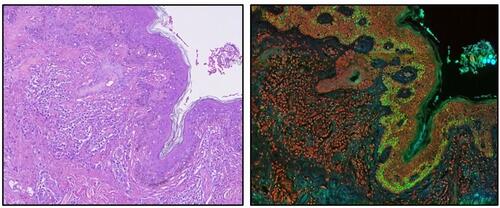Gene Involved In Hereditary Neuroendocrine Tumors Identified
By LabMedica International staff writers
Posted on 22 Apr 2015
To date, 11 main genes whose mutations are responsible for pheochromocytomas and paragangliomas have been identified and of these, 6 are involved in cellular metabolism, more specifically, the Krebs cycle, which is the machinery used by cells to burn oxygen and obtain the energy required for cellular work. Posted on 22 Apr 2015
Pheochromocytomas and paragangliomas are rare diseases, with an incidence of three to eight cases per million inhabitants, yet in spite of this low incidence, they represent a paradigm in hereditary cancer because they are the tumors with the highest hereditary predisposition. Approximately 50% of the patients inherit and/or transmit the susceptibility to developing this cancer.

Image: Histopathology of a paraganglioma, a carotid body tumor (Photo courtesy of Nephron).
Scientists at the Spanish National Cancer Research Centre (Madrid, Spain) and their colleagues have described the presence of mutations in the Malate Dehydrogenase 2 (MDH2) gene in a family with very rare neuroendocrine tumors associated with a high hereditary component. The tumors known as pheochromocytomas with groups of chromaffin cells in the central nervous system and paragangliomas with non-chromaffin or parasympathetic paragangliomas of glomus cells, affect the suprarenal and parathyroid glands, respectively.
The investigators sequenced the whole exome of one of the tumors in a patient with multiple malignant pheochromocytomas and paragangliomas using a HiSeq2000 system (Illumina; San Diego, CA, USA). This tumor showed no mutations in any of the 11 genes associated with genetic susceptibility to developing the disease. Analysis and filtering of the almost 80,000 variants found in the sample allowed the identification of a mutation in the MDH2 gene, whose association with this type of cancer had not been described before. Between 6- and 14-fold lower levels of MDH2 protein expression were observed in MDH2-mutated tumors compared with control patients.
The authors concluded that their study suggest efforts should be aimed at searching for new metabolic abnormalities in patients with these tumors. They explained that they were collaborating with the European Network for the Study of Adrenal Tumors consortium in order to continue investigating the role of MDH2 in the disease. Only in this way, due to the fact that these are rare diseases, will they be able to obtain a significant number of patients to whom they can translate the results. The study was published in the March 2015 issue of the Journal of the National Cancer Institute.
Related Links:
Spanish National Cancer Research Center
Illumina











.jpg)

